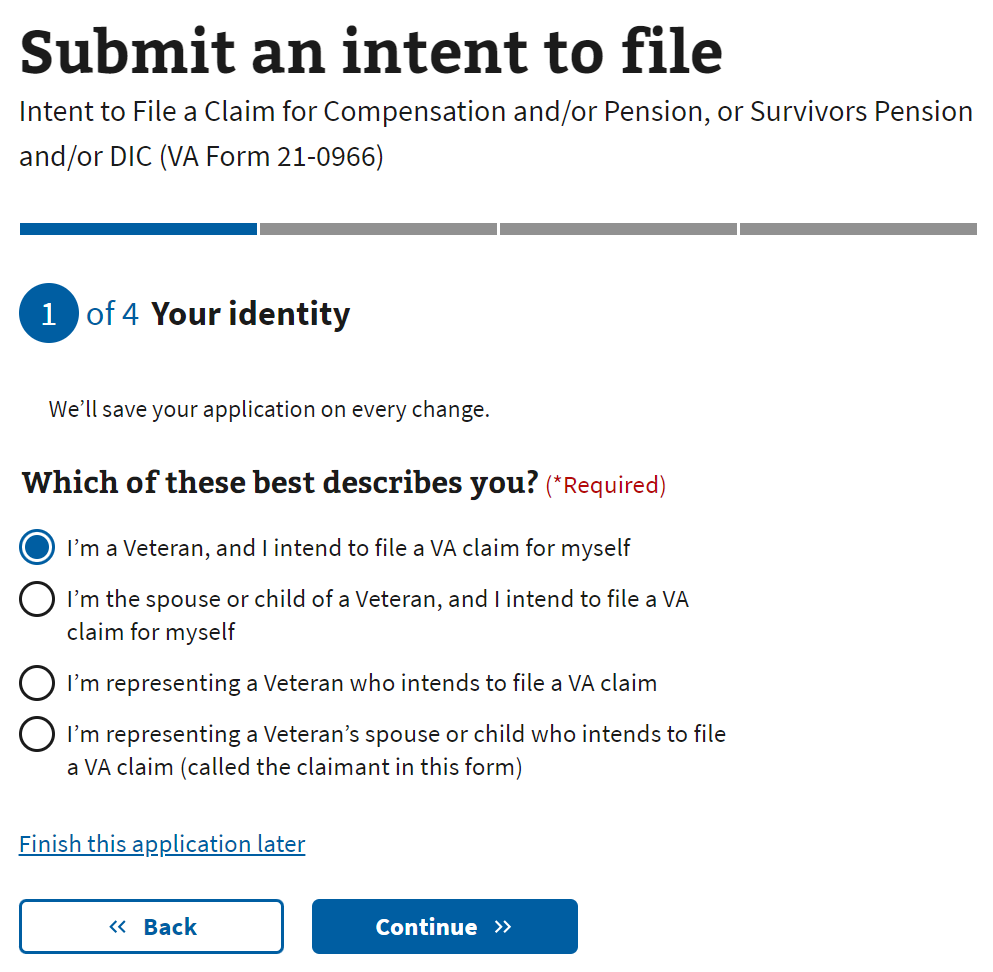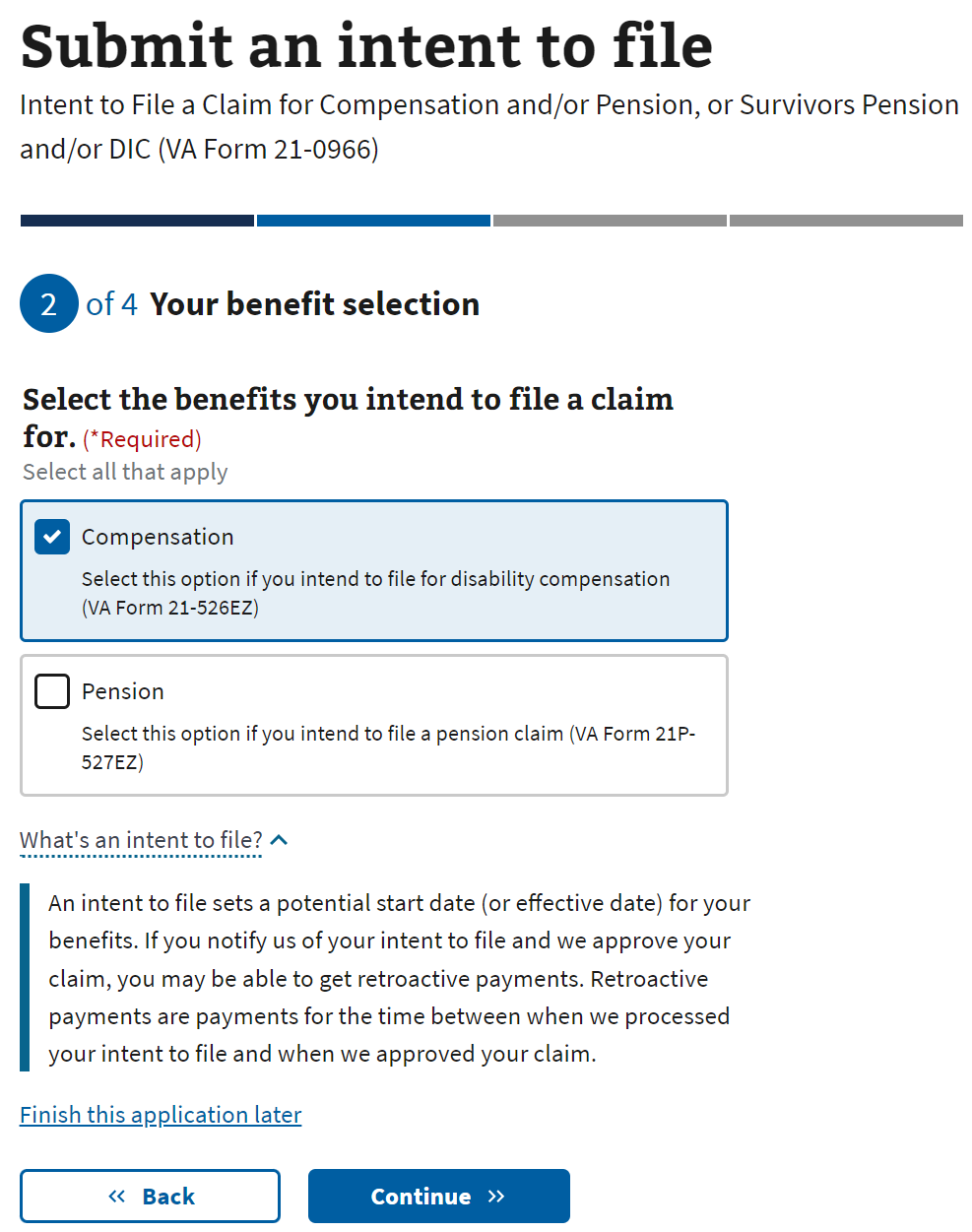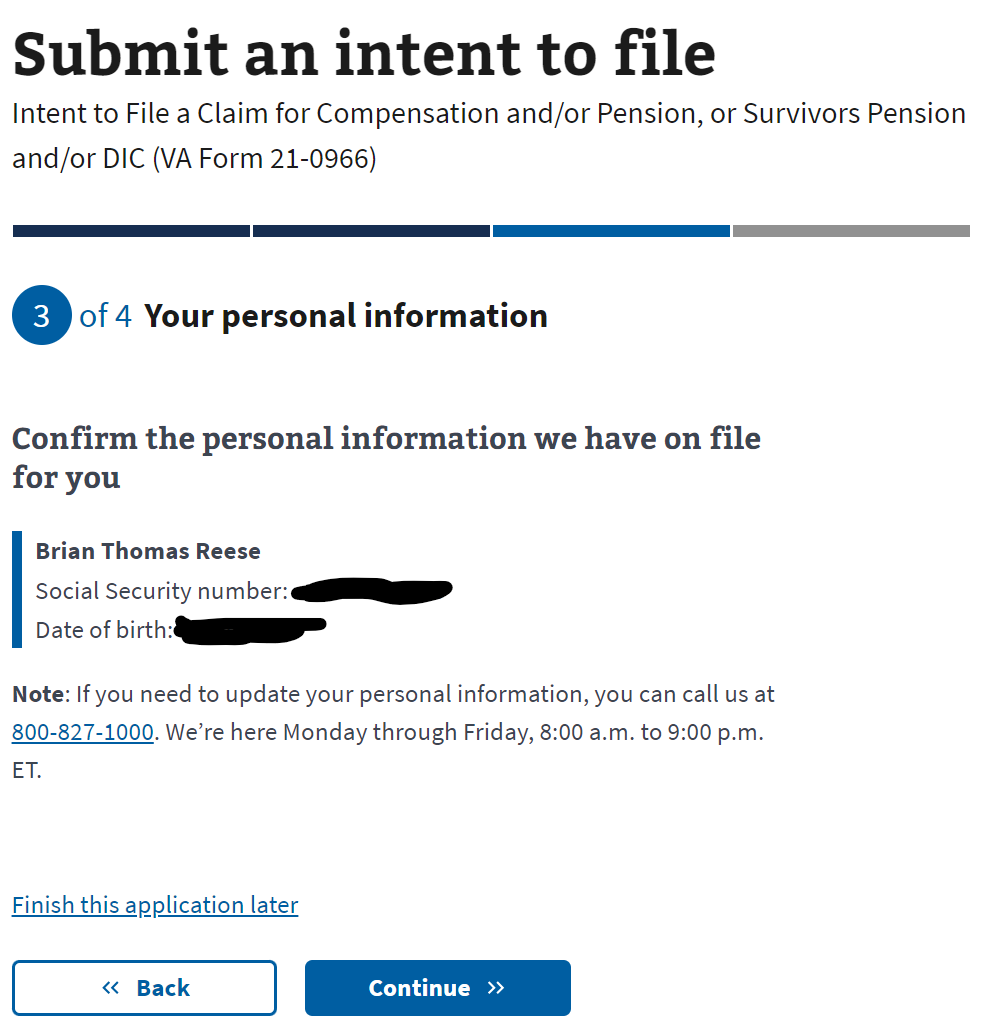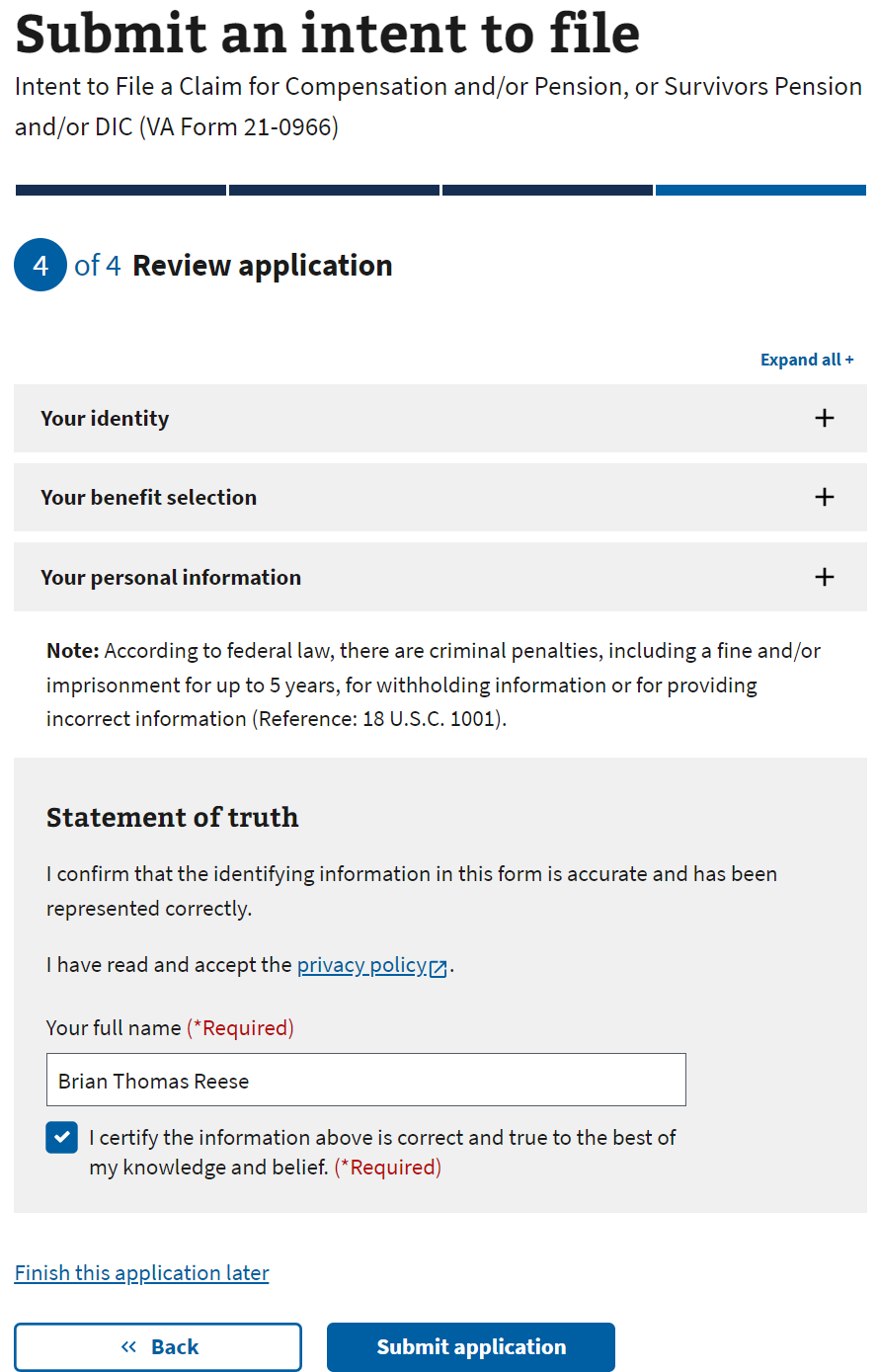Looking for Expert-Level VA Claim Answers?📱Call Us Now! 737-295-2226
When you’re thinking about filing claims for VA disability benefits, VA pension benefits, survivors’ pension, dependency and indemnity compensation (DIC), or supplemental claims not fully adjudicated, one of the most powerful tools you can use is the VA Intent to File (ITF).
This simple is mission critical because it locks in the effective date of your claim and, more importantly, means you’ll get back pay from your Intent to File date to when the VA decides your claim.
Let’s break down why an ITF is so critical, how it works, when it applies and when it doesn’t, along with how to submit one online step-by-step with screenshots.
Table of Contents
Summary of Key Points
- Importance of the Intent to File (ITF): The VA Intent to File (ITF) is a tool that allows veterans to notify the VA that they plan to file a claim for benefits. This process locks in an effective date, which is used to calculate retroactive payments (back pay) once the claim is approved.
- Why Your Effective Date Matters: Your effective date is critical because it determines when your benefits should start. By submitting an ITF, veterans lock in this date as early as the ITF submission, ensuring back pay from this date even if it takes time to submit the full claim.
- Multiple Options to Submit a VA Intent to File: Veterans can submit an ITF in various ways, including online through VA.gov Intent to File page, by calling 1-800-827-1000, or by mailing VA Form 21-0966. They can also submit it through a Veterans Service Organization (VSO) or in-person at a VA center.
- Applicable Claim Types: The ITF applies to VA disability compensation, VA pension, survivors’ pension, Dependency and Indemnity Compensation (DIC), and supplemental claims that are not fully adjudicated. However, it does not apply to requests for dependency, higher-level reviews, or claims based on clear and unmistakable error (CUE), among others listed below.
What is an Intent to File?
An Intent to File is exactly what it sounds like—it’s your way of telling the VA that you plan to submit a formal claim for benefits.
But more than just a notice, the ITF locks in your effective date, which is key when it comes to receiving back pay.
The earlier your effective date, the more back pay you could potentially receive once your claim is approved.
Back pay is the lump sum of benefits that covers the period between the effective date of your claim and the date the VA approves your benefits.
By submitting an ITF, you ensure that your effective date can be as early as the date you file your ITF, even if it takes you months to get your full claim submitted.
Why is the Effective Date So Important for Back Pay?
The effective date determines when your VA benefits should have started.
When the VA approves your claim, they will calculate your back pay based on this date.
The Intent to File sets this effective date to the day you notified the VA of your intention, even before your full claim is complete.
Let’s say you submit an ITF on January 1st, but you don’t file your full claim until November 1st.
If your claim is approved, your benefits will be paid retroactively back to January 1st, giving you 10 months of additional benefits.
How to Submit an Intent to File
There are multiple ways to submit an ITF to the VA, depending on what benefits you are pursuing:
#1. Submit Online via VA.gov
You can submit your Intent to File through the VA’s website by starting an application for benefits.
This automatically notifies the VA of your ITF without requiring a separate form.
The online submission works for:
Pro Tip: When you start your VA disability or VA pension application online, the VA is automatically notified of your intent to file. This is also true of Supplemental Claims submitted online.
#2. Call the VA at 1-800-827-1000
You can also submit an ITF by calling the VA at 1-800-827-1000 and telling them of your intent to file.
#3. Complete and Mail the VA Form 21-0966
If you prefer, you can complete VA Form 21-0966 (Intent to File a Claim for Compensation and/or Pension, or Survivors Pension and/or DIC) and mail it to the VA.
In-Person or Through a VSO
You can notify the VA in person by visiting a Veterans Service Center or by working with a Veterans Service Organization (VSO) representative who can submit the ITF on your behalf.
How to Submit a VA Intent to File Online (Step-by-Step Tutorial)
In this short 4-step tutorial with screenshots, Brian Reese the VA Claims Insider will teach you how to start and submit your Intent to File online at VA.gov in ~5 minutes.
Note: you must first be logged into your VA.gov account. Click here to sign-in to your account on the VA’s official Intent to File page and follow along step-by-step.
Step #1: Your Identity and Situation That Best Describes You
In this step, you’ll need to select the situation that best describes you. For example, you can select “I’m a veteran, and I intend to file a VA claim for myself,” or “I’m the spouse or child of a veteran, and I intend to file a VA claim for myself.” There’s also options for VA-accredited representatives. Once you’ve made your selection, click “Continue.”

Step #2: Select the Type of Claim You Intend to File
In this step, you’ll need to select the type of claim you intend to file. The online Intent to File application only includes VA disability compensation claims (VA Form 21-526EZ) and VA pension claims (VA Form 21P-527EZ). Once you’ve selected your claim type, click “Continue.”

Step #3: Verify Your Personal Information
In this step, you’ll need to verify the personal information the VA has on file, to include your social security number and date of birth. If it’s not correct, please call 1-800-827-1000, speak to a VA representative, and get it fixed before proceeding. If everything looks good, click “Continue.”

Step #4: Review and Submit Your VA Intent to File Online
In the final step, review your Intent to File application and ensure everything is correct. You’ll need to type your full name in the Statement of Truth box and certify that the information is correct and true to the best of your knowledge and belief. If you’re good with everything, click the “Submit Application” to file your Intent to File with the VA.

What Happens After Submitting an ITF?
Once you’ve submitted your ITF, you have one year to complete your claim.
During this time, your effective date is preserved, meaning your benefits will be calculated from the date of your ITF submission, not from when you filed your full claim.
This is a game-changer for veterans who need time to gather medical records, documentation, or other supporting evidence before filing the full claim.
What If I Miss the One-Year Deadline?
If you don’t submit your full claim within one year of filing your ITF, your effective date will expire, and you’ll need to submit a new ITF.
This means any back pay will only be calculated from the date of your new ITF submission, potentially losing you months of benefits.
The VA Intent to File Applies to These Types of Claims
The Intent to File (ITF) applies to the following types of VA benefit claims:
- Compensation: For veterans seeking disability compensation.
- Pension: For low-income veterans who are permanently and totally disabled or over the age of 65.
- Survivors Pension: For surviving spouses and dependents of veterans.
- DIC (Dependency and Indemnity Compensation): A benefit for eligible survivors of veterans who died as a result of service-connected conditions.
- Supplemental Claims: Before July 30, 2021, 38 CFR 3.155 precluded the application of ITFs to supplemental claims. In Military-Veterans Advocacy v. Secretary of Veterans Affairs, No. 19-1600 (Fed. Cir. 2021), the court invalidated this portion of VA’s regulation. This means an ITF may now be applied to supplemental claims that are not finally adjudicated on or after July 30, 2021.
The VA Intent to File Does NOT Apply to These Types of Claims
According to M21-1, Part II, Subpart iii, Chapter 2, Section A – Intent to File (ITF), the ITF does not apply to certain other claims and requests, such as:
- Requests for Dependency: These are separate claims to add dependents, such as children or spouses, to an existing VA claim.
- Ancillary Benefits: Benefits such as educational assistance, housing grants, or special adaptive housing do not qualify for an ITF.
- Requests for a Higher-Level Review (HLR): If you’re seeking a review of a previous VA decision through a higher-level review, you cannot file an ITF.
- Duplicate Claims: If you’ve already submitted an ITF for the same benefit, filing another one will have no effect.
- Clear and Unmistakable Error (CUE) Requests: Claims based on an error in a previous decision do not qualify for an ITF.
How Do I Keep Track of My ITF?
Once you’ve submitted an ITF, you can track its status through your VA.gov account or by contacting the VA directly.
Your ITF remains active until either:
- The VA receives a complete claim, or
- One year passes since your ITF submission.
If you submit multiple ITFs for the same benefit, only the first one will be valid.
After you file a claim that closes out an ITF, you can submit another ITF if needed.
Why Your Intent to File Date Matters: Back Pay Impact Example
To illustrate the importance of filing an ITF, consider this: If you wait until your claim is fully developed before filing, you could miss out on months of back pay.
But with an ITF in place, even if you take a few months to gather all your documentation, your effective date—and potential back pay—remains the day you filed your ITF.
For example, if a veteran files an ITF for a service-connected disability on January 1st, gathers evidence for several months, and then submits a complete claim on June 1st, their effective date will still be January 1st.
In this example, it would result in five months of back pay between your effective date and award decision date.
Conclusion & Wrap-Up: Don’t Wait—File Your ITF ASAP!
The VA Intent to File is an essential strategy for veterans to protect their effective date and maximize back pay.
It’s a low-effort, high-reward step in the VA claims process that ensures you won’t lose out on months—sometimes even years—of benefits.
If you’re considering filing a claim for compensation and benefits, make sure your first step is submitting an ITF, assuming it applies to your situation.
Whether you do it online, by phone, or with a VSO, this crucial move will lock in your effective date and ensure that you get every penny of the benefits you’ve earned.
Fellow Veterans: You Served; You Deserve!
Make sure to file your Intent to File VA as early as possible to maximize your back pay and protect your benefits.
VA Intent to File Explained: Frequently Asked Questions (FAQs)
What is a VA Intent to File (ITF)?
A VA Intent to File (ITF) is an official notification to the Department of Veterans Affairs (VA) that you intend to file a claim for VA benefits. The ITF is critical because it locks in your effective date, which is used to calculate any retroactive payments (back pay) once your claim is approved. This ensures that even if it takes time to gather the necessary documentation, your benefits can start from the ITF submission date.
Why is the effective date so important for my VA claim?
The effective date is crucial because it determines when your benefits should have started. Once your claim is approved, the VA uses the effective date to calculate your back pay. By filing an ITF, your effective date is locked in as the day the VA receives your ITF, not the date your full claim is submitted. This means you could receive months of back pay once your claim is approved.
How do I submit an Intent to File?
You can submit an ITF in multiple ways:
- Online: Start an application for benefits on VA.gov, and the system will automatically submit your ITF.
- By Phone: Call the VA at 1-800-827-1000 to notify them of your intent to file.
- By Mail: Submit VA Form 21-0966 (Intent to File a Claim) by mail.
- In-Person or Through a VSO: Visit a Veterans Service Center or work with an accredited Veterans Service Organization (VSO) to submit your ITF on your behalf.
What types of claims can I file using an ITF?
The ITF applies to several types of VA benefit claims, including:
- VA Disability Compensation
- VA Pension Benefits
- Survivors Pension
- Dependency and Indemnity Compensation (DIC)
- Supplemental Claims (as of July 30, 2021, due to the Military-Veterans Advocacy v. Secretary of Veterans Affairs court decision).
Does the Intent to File apply to Supplemental Claims?
Yes! As of July 30, 2021, an ITF can be applied to Supplemental Claims that are not fully adjudicated. This allows veterans who submit a Supplemental Claim within one year of an ITF to preserve an earlier effective date and potentially receive more back pay.
What types of claims do not qualify for an Intent to File?
Certain types of claims are not eligible for an ITF. These include:
- Requests for Dependency (e.g., adding a spouse or child to your claim)
- Ancillary Benefits (e.g., educational assistance, housing grants)
- Requests for VA Higher-Level Reviews (HLR)
- Duplicate Claims (filing multiple ITFs for the same benefit)
- Clear and Unmistakable Error (CUE) Requests
What happens if I miss the one-year deadline after filing an ITF?
If you don’t submit a complete claim within one year of filing an ITF, your effective date will expire. This means you will need to submit a new ITF to establish a new effective date, and any back pay will only be calculated from the date of the new ITF, potentially causing you to lose months of benefits.
Can I submit multiple ITFs for different benefits?
Yes. You can submit ITFs for different types of benefits, such as one for disability compensation and another for pension. However, if you submit multiple ITFs for the same benefit type within the same period, only the first ITF will be valid.
How do I track the status of my ITF?
You can track the status of your ITF through your VA.gov account or by contacting the VA. The ITF remains active until either:
- A complete claim is filed, or
- One year passes from the ITF submission date.
If you submit multiple ITFs for the same benefit type, only the first one will be valid.
What are the benefits of submitting an ITF?
The key benefit of submitting an ITF is that it locks in your effective date, which protects your back pay. This is especially valuable if you need time to gather supporting documentation for your claim, as it ensures your benefits will be calculated from the date the ITF was received, not the date your full claim is submitted. It’s a simple way to make sure you don’t lose out on months of benefits.
What happens after I submit my Intent to File?
Once you submit an ITF, you have one year to complete and submit your full claim. Your effective date is preserved during this time. If your claim is approved, your back pay will be calculated from the ITF date, ensuring you get retroactive payments from the day you submitted the ITF, not from when you filed your full claim.
Looking for VA Claim Help ASAP? WE GOT YOUR SIX!

- VA Claims Insider is the #1 most trusted name in VA disability claims.
- Work directly with a VA claims coach who can help lead you to VA claim victory.
- 25,000+ disabled veterans served in our membership programs since 2016.
- 30% average rating increase for veterans who complete our #1 rated Elite program.
- 4.7/5.0 average rating out of 5,500+ total reviews; over 4,500 5-star reviews.
About the Author

Brian Reese
Brian Reese is a world-renowned VA disability benefits expert and the #1 bestselling author of VA Claim Secrets and You Deserve It. Motivated by his own frustration with the VA claim process, Brian founded VA Claims Insider to help disabled veterans secure their VA disability compensation faster, regardless of their past struggles with the VA. Since 2013, he has positively impacted the lives of over 10 million military, veterans, and their families.
A former active-duty Air Force officer, Brian has extensive experience leading diverse teams in challenging international environments, including a combat tour in Afghanistan in 2011 supporting Operation ENDURING FREEDOM.
Brian is a Distinguished Graduate of Management from the United States Air Force Academy and earned his MBA from Oklahoma State University’s Spears School of Business, where he was a National Honor Scholar, ranking in the top 1% of his class.



